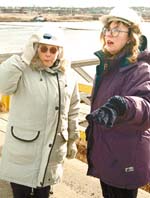
Dr. Rosalie Bertell (left), of the International Institute of Concern for Public Health (IICPH) and Elizabeth May, executive director of the Sierra Club of Canada take a first hand look at the Sydney tar ponds Thursday prior to a press conference on the issues surrounding the cleanup of the more than 700,000 tons of toxic sludge.

 Whitney Pier - A new report says Frederick Street
residents are at risk living next to the toxic coke
ovens site.
Whitney Pier - A new report says Frederick Street
residents are at risk living next to the toxic coke
ovens site.